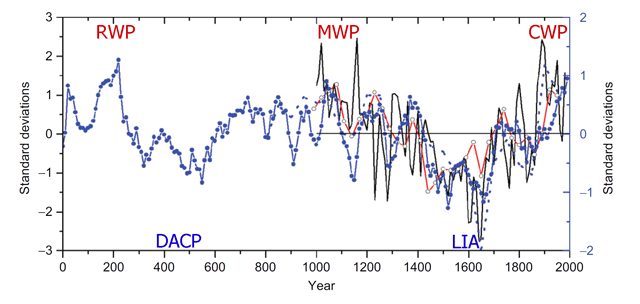Reference
Yang, B., Wang, J., Brauning, A., Dong, Z. and Esper, J. 2009. Late Holocene climatic and environmental changes in arid central Asia. Quaternary International 194: 68-78.
What was done
The authors synthesized proxy records of temperature and precipitation in arid central Asia over the past two thousand years, focusing on the relationship between temperature and precipitation on timescales ranging from annual to centennial.
What was learned
With respect to temperature, Yang et al. report that "the most striking features are the existence of the Medieval Warm Period (MWP) and the Little Ice Age (LIA)," both of which can readily be seen in the figure below, which also reveals the existence of the earlier Roman Warm Period (RWP) and Dark Ages Cold Period (DACP), as well as what they call "a recent warming into the 20th century," which have we denominated the Current Warm Period (CWP). As for precipitation, the five researchers say the MWP "corresponded to an anomalously dry period whereas the cold LIA coincided with an extremely wet condition."

Standardized representations of various reconstructions of the temperature history of arid central Asia. Adapted from Yang et al. (2009).
What it means
Once again, we have a substantive body of evidence for the natural, non-CO2-induced, millennial cycling of climate that has alternately brought the world into -- and then out of -- the Roman Warm Period, the Dark Ages Cold Period, the Medieval Warm Period and the Little Ice Age, which gives us every reason to believe that its continued operation has likely brought the planet into the Current Warm Period, and that this natural phenomenon will likely bring the world out of its latest extended "heat wave," sometime in the future.




